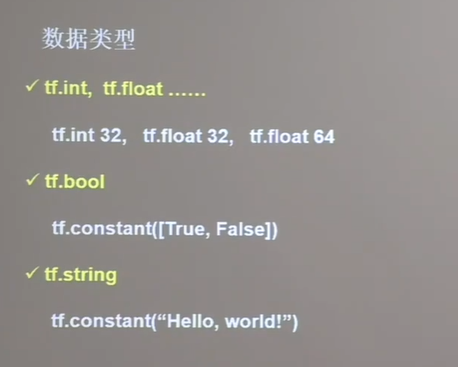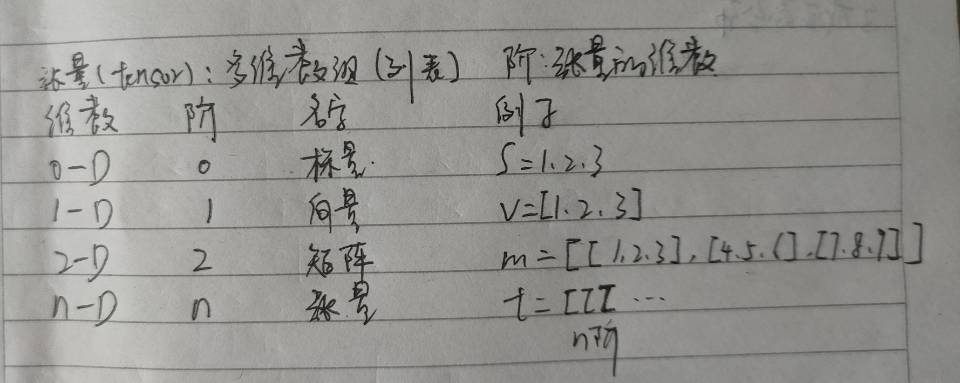寒假学习进度4:tensorflow2.0张量的创建
tensor(张量):
数据类型:


1.直接创建向量:
tf.constant(张量内容,dtype=数据类型)
import tensorflow as tf t=tf.constant([2,3],dtype=tf.int64)#创建一个一阶张量,dtype表示类型,为int64 print(t) >>tf.Tensor([2 3], shape=(2,), dtype=int64)#shape中有几个数就代表几阶
2.用numpy数据类型转换为tensor类型

import tensorflow as tf import numpy as np a=np.arange(0,5) t=tf.convert_to_tensor(a,dtype=tf.int64)#将一维数组转化为一维张量,a为 print(a,t) >>[0 1 2 3 4] tf.Tensor([0 1 2 3 4], shape=(5,), dtype=int64)
3.创建特殊的张量。
(1)全为0的张量:维度如何表示:一维直接填一个数字,二维用[行,列],多维用[n,m,j,k……]
tf.zeros(3)#创建一维零张量:只需要指定张量内容中0的个数 tf.zeros([2,3])#二维 >><tf.Tensor: shape=(3,), dtype=float32, numpy=array([0., 0., 0.], dtype=float32)> <tf.Tensor: shape=(2, 3), dtype=float32, numpy=array([[0., 0., 0.], [0., 0., 0.]], dtype=float32)>
(2)全为1的张量:维度同上
tf.ones(3)
>><tf.Tensor: shape=(3,), dtype=float32, numpy=array([1., 1., 1.], dtype=float32)>
(3)全为指定值的张量
tf.fill([2,3],1) >><tf.Tensor: shape=(2, 3), dtype=int32, numpy=array([[1, 1, 1], [1, 1, 1]])>
(4)生成正态分布随机数:tf.random.normal(维度,mean=均值,stddev=标准差)(默认均值为0,标准差为1)
tf.random.normal([3,3],mean=1,stddev=0.5) >><tf.Tensor: shape=(3, 3), dtype=float32, numpy=array([[0.5939642 , 0.7801706 , 0.73448145], [0.07946539, 1.8461295 , 1.7190137 ], [0.7935035 , 1.1642232 , 0.63996214]], dtype=float32)>
(5)生成截断式正态分布的随机数(即生成的随机数位于(均值-2标准差,均值+2标准差)范围):tf.random.truncated_normal(维度,mean=均值,stddev=标准差)
tf.random.truncated_normal([3,3],mean=1,stddev=0.5) >><tf.Tensor: shape=(3, 3), dtype=float32, numpy=array([[1.3027463 , 1.8570051 , 1.3586129 ], [1.5800164 , 1.2975678 , 0.7345885 ], [1.7934418 , 0.97875464, 1.0045136 ]], dtype=float32)>

(6)生成均匀分布的随机数:tf.random.uniform(维度,minval=最小值,maxval=最大值)
tf.random.uniform([3,3],minval=0,maxval=1) >><tf.Tensor: shape=(3, 3), dtype=float32, numpy=array([[0.8119303 , 0.97470737, 0.5821942 ], [0.07488775, 0.375291 , 0.68286586], [0.23914921, 0.16803873, 0.78797734]], dtype=float32)>



